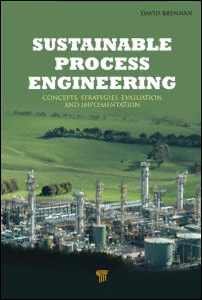Table Of ContentSustainableProcessEngineering.indd 1 8/27/12 2:32:01 AM
TThhiiss ppaaggee iinntteennttiioonnaallllyy lleefftt bbllaannkk
CRC Press
Taylor & Francis Group
6000 Broken Sound Parkway NW, Suite 300
Boca Raton, FL 33487-2742
© 2012 by Taylor & Francis Group, LLC
CRC Press is an imprint of Taylor & Francis Group, an Informa business
No claim to original U.S. Government works
Version Date: 2012912
International Standard Book Number-13: 978-9-81436-422-5 (eBook - PDF)
This book contains information obtained from authentic and highly regarded sources. Reason-
able efforts have been made to publish reliable data and information, but the author and publisher
cannot assume responsibility for the validity of all materials or the consequences of their use. The
authors and publishers have attempted to trace the copyright holders of all material reproduced in
this publication and apologize to copyright holders if permission to publish in this form has not
been obtained. If any copyright material has not been acknowledged please write and let us know so
we may rectify in any future reprint.
Except as permitted under U.S. Copyright Law, no part of this book may be reprinted, reproduced,
transmitted, or utilized in any form by any electronic, mechanical, or other means, now known or
hereafter invented, including photocopying, microfilming, and recording, or in any information
storage or retrieval system, without written permission from the publishers.
For permission to photocopy or use material electronically from this work, please access www.
copyright.com (http://www.copyright.com/) or contact the Copyright Clearance Center, Inc.
(CCC), 222 Rosewood Drive, Danvers, MA 01923, 978-750-8400. CCC is a not-for-profit organiza-
tion that provides licenses and registration for a variety of users. For organizations that have been
granted a photocopy license by the CCC, a separate system of payment has been arranged.
Trademark Notice: Product or corporate names may be trademarks or registered trademarks, and
are used only for identification and explanation without intent to infringe.
Visit the Taylor & Francis Web site at
http://www.taylorandfrancis.com
and the CRC Press Web site at
http://www.crcpress.com
August27,2012 15:33 PSPBook-9inx6in 00-David-Brennan–prelims
Contents
Acknowledgements xvii
Preface xix
PARTA: CONCEPTS
IntroductiontoPartA 3
1 SustainabilityConcepts 9
1.1 TheConceptofSustainableDevelopment 9
1.2 SustainabilityintheContextoftheProcessIndustries 13
1.3 SomeTemporalCharacteristicsofSustainability 14
1.3.1 TimeHorizonsinProjectEvaluation 14
1.3.2 TimeHorizonsforTechnologyDevelopment 14
1.3.3 TimeDependenceofTechnologyImprovement 14
1.3.4 RobustnesstoTechnological,Economic,and
RegulatoryChange 15
1.3.5 AppraisalofUncertainties(Technical,Business,and
Environmental) 15
1.4 TheSustainableProjectorIndustry 15
1.5 ConflictsinAchievingSustainabilityObjectives 16
2 CleanerProduction 19
2.1 Introduction 19
2.2 TheConceptof‘CleanerProduction’ 19
2.3 TheProductLifeCycle 20
2.4 HierarchyofWasteManagement 23
2.5 ConceptsandSourcesofWaste 24
2.5.1 ConceptsofWaste 24
2.5.2 ProcessandUtilityWaste 24
2.5.3 UtilityWasteandSystemBoundaryDefinition 25
2.5.4 Packaging 27
August27,2012 15:33 PSPBook-9inx6in 00-David-Brennan–prelims
vi Contents
2.6 ImpactsofWaste 27
2.7 ClassificationofWaste 27
2.8 DrivingForcesforCleanerProduction 28
2.9 ResistancestoIntroducingCleanerProduction 28
2.10ConcludingRemarks 29
3 IndustrialEcology 31
3.1 TheBasicConceptofIndustrialEcology 31
3.2 EnergyandMaterialsRecoveryfromWasteStreams 34
3.3 ResourceFlowthroughtheEconomy 34
3.3.1 SulphurFlowinAustralia 34
3.4 TransportandStorageofRawMaterialsandProducts 35
3.4.1 MarineTransport 36
3.4.2 RoadandRailTransport 36
3.5 IntegratedSiteManufacture 36
3.6 SomeExamplesofIndustrialEcologyInitiatives 38
3.6.1 Case1:HydrogenUtilisationfromRefineries 38
3.6.2 Case2:FertiliserComplex,Queensland,Australia 39
3.6.3 Case3:IndustrialIntegrationatKalundborg,Denmark 40
3.6.4 Case4:IndustrialSymbiosisatKwinana,Western
Australia 41
3.7 ConcludingRemarks 42
Problems: PartA 45
PARTB: STRATEGIES
IntroductiontoPartB 53
4 WasteMinimisationinReactors 55
4.1 Introduction 55
4.2 AChecklistforReactionSystemsandReactors 56
4.3 ChemistryofProcessRoute 57
4.3.1 Conversion,Selectivity,andYield 59
4.3.2 Co-ProductandBy-ProductUtilisation 60
4.4 ImpuritiesinReactorFeedstocks 60
4.5 MixingofReactants 62
4.5.1 MixingofGaseousReactants 62
4.5.2 MixingofLiquids 62
4.5.3 FluidDistributioninPackedBedReactors 62
August27,2012 15:33 PSPBook-9inx6in 00-David-Brennan–prelims
Contents vii
4.6 MinimisingSecondaryReactions 63
4.7 RecycleofUnreactedFeedfromReactorOutlet 64
4.8 ReversibleReactions 64
4.9 Catalysis 65
4.9.1 ExampleoftheEffectofCatalystActivityon
Performance 66
4.10 AgentMaterials 67
4.11 CaseExamples 67
4.12 Chlor-AlkaliProductioninMercuryCell 68
4.12.1TransportPaths 69
4.12.2OtherAspectsoftheMercuryCellChlorine
Process 71
4.13 EthyleneManufacturefromHydrocarbons 71
4.14 HydrogenCyanideManufacturefromAmmonia,Methane,
andAir 73
4.15 SulphuricAcidManufacture 75
4.16 PVCProductionbySuspensionPolymerisationofVinyl
ChlorideMonomer 78
4.17 ConcludingRemarks 80
5 WasteMinimisationinSeparationProcesses 83
5.1 ClassificationofSeparationProcesses 83
5.2 SourcesofWasteinSeparationProcesses 84
5.3 Distillation 85
5.4 GasAbsorption 87
5.5 Adsorption 90
5.6 Filtration 91
5.6.1 CentrifugalSeparation 92
5.6.2 FiltrationofSolidsfromGasStreams 92
5.6.3 SeparationofLiquidParticulatesfromGas
Streams 92
5.7 Drying 93
5.8 EvaporationandCondensation 93
5.9 Solid–LiquidExtraction 94
5.10Liquid–LiquidExtraction 95
5.11UseofExtraneousMaterials 95
5.11.1ExampleofExtraneousMaterialUse—SulphuricAcid
inChlorineDrying 96
5.12CaseExamples 97
5.12.1CaseExample—SolidSodiumCyanidePlant 98
August27,2012 15:33 PSPBook-9inx6in 00-David-Brennan–prelims
viii Contents
5.12.2OtherCaseExamplesofGasAbsorptioninChemical
Processes 99
5.12.3CaseExamplesinDistillation 100
5.13ConcludingRemarks 101
6 IdentificationofWasteinUtilitySystems 103
6.1 Introduction 103
6.2 Fuels 105
6.3 FuelCombustion 105
6.3.1 HeatofCombustion 106
6.3.2 ExcessAir 107
6.4 CommonFuels 107
6.5 EnvironmentalImpactsofFlueGases 109
6.5.1 NO FormationinFuelCombustion 110
x
6.6 TheoreticalFlameTemperatures 111
6.7 Furnaces 111
6.8 FlareStacks 112
6.9 SteamGeneration 113
6.10SteamUse 116
6.11WaterSourcesandUses 119
6.11.1WaterQualityIndicators 120
6.12RecirculatedCoolingWaterfromCoolingTowers 121
6.13SeaWaterCooling 123
6.14AirCooling 124
6.15Refrigeration 124
6.16ElectricityDemandandSupply 126
6.17DistributionandUseofElectricity 129
6.18CompressedAir 130
6.19InertGas 130
6.20Vacuum 131
6.21ConcludingRemarks 131
7 EnergyConservation 133
7.1 Introduction 133
7.2 EnergyConsumptioninCompressionofGases 134
7.2.1 ProcessSpecificationforGasCompressors 134
7.2.2 MachineSelection 134
7.2.3 ThermodynamicsofGasCompression 136
7.2.4 LimitstoCompressionRatioperStageofCompression 138
7.2.5 IntercoolingofGasduringCompression 138
August27,2012 15:33 PSPBook-9inx6in 00-David-Brennan–prelims
Contents ix
7.2.6 Reliability 138
7.2.7 DrivesforCompressors 139
7.2.8 EnergyConservationinGasCompression 139
7.3 EnergyConsumptioninPumpingofLiquids 139
7.3.1 ProcessSpecificationforPumps 139
7.3.2 PowerRequirement 141
7.3.3 PumpMachineTypes 141
7.3.4 CentrifugalPumpSelectionandPerformance 142
7.3.5 EnergyConservationinPumpingofLiquids 144
7.4 PressureLossesinPiping 144
7.4.1 SizingofPipes 144
7.5 PressureLossthroughEquipment 145
7.5.1 HeatExchangers 145
7.5.2 Vapour–LiquidContactingColumns 146
7.6 AgitationandMixing 147
7.7 HeatRecovery 149
7.8 EnergyRecoveryfromHighPressureStreams 150
7.9 Insulation 150
7.10PlantLayout 151
7.11ConcludingRemarks 151
8 MaterialsRecycling 155
8.1 Introduction 155
8.2 RecyclingofMaterialsinChemicalProcesses 155
8.2.1 EconomicsofRecyclingProcessStreams 156
8.2.2 EnvironmentalCreditsandBurdensofRecycling 156
8.3 ClosedLoopandOpenLoopRecycling 157
8.4 On-SiteandOff-SiteRecycling 159
8.4.1 ExamplesofOff-SiteRecycling 159
8.5 ProducerandConsumerWaste 159
8.6 HierarchicalApproachtoMaterialsRecycling 160
8.7 PlasticsRecycling 161
8.8 GlassRecycling 163
8.9 RecyclingofMaterialsfromProducts 164
8.10WasteTreatmentOption 164
8.11AqueousEffluentTreatmentandWaterRecycling 165
8.12DisposalofWastes 167
8.12.1 Landfill 167
8.12.2 Incineration 168
8.13ConcludingRemarks 169

